Stone Town

 Having missed the faster 1.5 hour ride, we were stuck on a 6 hour ferry. I thought I was severely sea sick (pictured left), and although that may have been part of the problem, I was also worried I had contracted malaria. Malaria is no laughing matter and even after treatment the death rate can be as high as 10%. So after landing in Zanzibar I got tested and thankfully the results were negative (pictured right with the physician).
Having missed the faster 1.5 hour ride, we were stuck on a 6 hour ferry. I thought I was severely sea sick (pictured left), and although that may have been part of the problem, I was also worried I had contracted malaria. Malaria is no laughing matter and even after treatment the death rate can be as high as 10%. So after landing in Zanzibar I got tested and thankfully the results were negative (pictured right with the physician).

 Having determined I wasn't going to die just yet, we set out to enjoy Stone Town, the island's oldest and most populous section. It got it's name because sultans and slave traders built their big seaside mansions and mosques out of the native rock. From the very beginning we found Stone town to be the perfect tropical paradise where you're treated like a king in a stunningly gorgeous environment.
Having determined I wasn't going to die just yet, we set out to enjoy Stone Town, the island's oldest and most populous section. It got it's name because sultans and slave traders built their big seaside mansions and mosques out of the native rock. From the very beginning we found Stone town to be the perfect tropical paradise where you're treated like a king in a stunningly gorgeous environment.
Zanzibar is known for its fine spices so we took a spice tour the next day. But because of my lingering illness we left early and I went to a physician who diagnosed me with bronchitis. After some antibiotics we set out again to enjoy the island. One of the first things I noticed about Zanzibar was its unique architecture that seemed to draw from a number of very different cultures. Perhaps the most famous aspect of architecture are the island's carved wooden doors, some of which are older than the houses in which they're set. The door was often the first part to be built and served as a symbol of wealth and status. Some of these are pictured below. Some featured large spikes, which is a tradition from India where the spikes protected doors from being battered down by elephants.
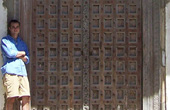 |
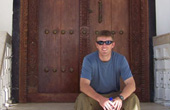 |
 |
As we moved away from the town center we began to see some of the other historical landmarks, and one of the most powerful was certainly the Anglican Cathedral and old slave market. The church was built in 1887 on the site of the old slave market to commemorate the end of the slave trade. Allegedly the alter was constructed over the old whipping block. In the second picture below I'm sitting in the pews, and the third photo features a monument just outside on the church grounds. We were also able to visit holding cells under St. Monica's Hostel, pictured in the fourth photo below.
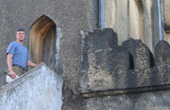 |
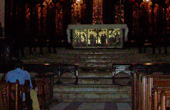 |
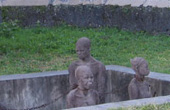 |
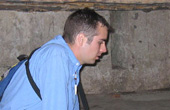 |
Stone Town had a number of unique places to see, some of which are pictured below. The fish market was interesting, but the smell of rotting fish was unbearable. In the third picture below a shark sits cut up on the street, waiting for a buyer. As the sun set we made our way to the Africa Hotel which offered a great view of the Indian Ocean.
 |
 |
 |
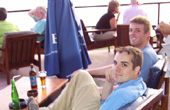 |
One of the nicest things about Zanzibar was that it afforded us greater opportunity to mingle with other travelers. The first two pictures below are of a bustling food market in the evening. Solomon is in the second picture frying up some food for us. The third is of us with two French girls at Mercury's, a bar named after Queen singer Freddie Mercury, who was born in the neighborhood. The four of us also visited the Old Fort one last time.
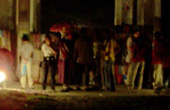 |
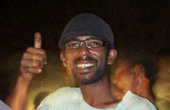 |
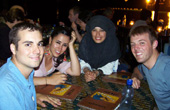 |
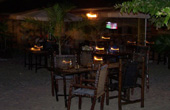 |
Stone Town was a fascinating place, but the beach was calling our name and so we hopped in a bus and went to the island's northern tip. Click here for more on that.